Growing orchids is mainly knowing how to properly imitate the orchid’s natural habitats and recreating that environment in your house. A few orchids aren’t accustomed to a lot of light at all, and prefer low light conditions. If you are interested in growing orchids indoors, then you might want to consider low light orchids.
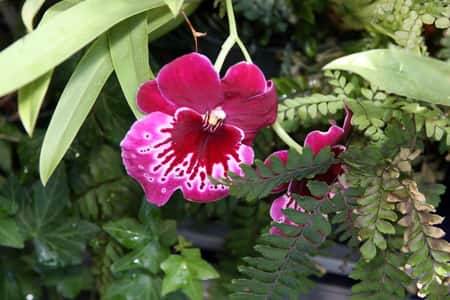
What orchids are best for low light? A window sill with bright direct light isn’t necessary for these kinds of orchids:
Phalaenopsis,
Paphiopedilums,
and Miltoniopsis.
Those are the 3 most famous orchids, that can be bought a practically any good nursery. The other 30 orchids that thrive in low light conditions are less common and harder to find, but still accessible are:
(1) Areanthes Ramosa;
(2) Bulbophyllum catenulatum;
(3) Bulbophyllum facetum;
(4) Calanthe argenteo-striata;
(5) Ceratostylis backeri (Java);
(6) Chrysoglossum (Pilophyllum) villosum;
(7) Coelogyne prasina;
(8) Dendrobium aberrans;
(9) Dendrobium cuthbertsonii;
(10) Dracula;
(11) Dryadella;
(12) Gastrochilus bellinus;
(13) Glossorhyncha;
(14) Haraella odorata;
(15) Lepanthes;
(16) Malaxis junghuhnii;
(17) Masdevallia bennettii;
(18) Maxiliaria;
(19) Mediocalcar bifolium;
(20) Paphinia rugosa;
(21) Phaius pulchellus v. pulchellus;
(22) Phymatidium tillandsioides;
(23) Platystele umbellate;
(24) Pleurothallis amphigya , Pleurothallis chrysantha (circumplexa), P. fusca (hypnicola), P. immersa (black), P. mastodon, P. matudana, P. microphylla, P. nephroglossa, P. pachyglossa , P. racemiflora, P. ruscifolia, P. sanchoi, P. sandemanii, and the P. strumosa;
(25) Podochilus muricatus,
(26) Porroglossum aureum, Porroglossum hoeijeri, and Porroglossum sergioi;
(27) Scaphosepalum anchoriferum (fortuna rojo);
(28) Trichosalpinx berlineri;
29) Tristella hoeijeri; and last but not least,
(30) Zootrophion (Cryptophoranthus) atropurpureus.
Low light is one thing, but no light is another. No plant will grow well if it is shoved into a dark corner of a forgotten bookshelf, hid under an end table, or left alone in a dark bathroom.
Although there are good candidates for bathroom orchids, they must have some source of light.
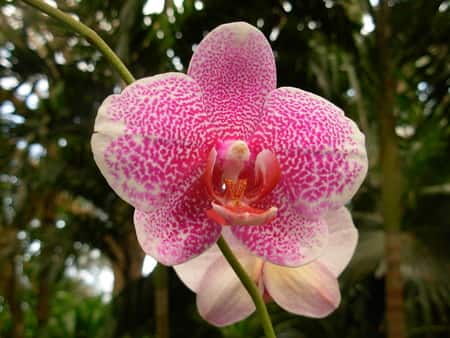
If you are thinking about acquiring an orchid for one of these darker spaces in your house, that get no light whatsoever, I’d strongly recommend against it. As long as there is light, even if artificial, then your orchid can make it.
In technical terms, you should be looking for orchids that fall into the low light category. When you light a candle, the amount of light that it gives off the first foot is how we measure light capacity for plants, called foot candles, or fc. When you research, search for orchids that will fall into the 1200 to 2000 fc requirements (some authors mention 1,000 to 1,200 fc). Any of those orchids will be fine for the spaces that you have in mind. If you want to read up on what the specific types of light requirements are, check out this article about lighting for orchids.
But as a general guide, at noon near the equator, you’ll be receiving 5,000 to 6,000 fc. Most continental United States will receive 3,000 to 4,000 fc at noon in July (this is really stretching it, but you get the idea). On a rainy day, overcast and dark blue skies, you’ll still have 80 fc. In office spaces, the recommended foot candles range from 50 to 100fc, yet for more detailed work, 200 foot candles is recommended.
As you can see, plants like light. Even the low light orchids start at 900 fc. So whatever you do, don’t place your orchid in the dark.
Let’s look at these low light orchids one by one, starting with the most common ones that can be found in almost all nurseries, flower shops and even big supermarkets.
(1) Phalaenopsis: The First Choice for Low-Light Orchids

Phalaenopsis Orchids will do best with low light because they grow in the shade. Another reason they are good choices, is because they are readily available to purchase in grocery stores and big box supermarkets—which makes them accessible.
The worst thing that can happen is that you invest a large quantity of money in an orchid to experiment with lighting locations, only to find out the place was too dark. By experiment, I mean exactly that. This is going to be an experiment. Each window is different, and each house is different.
It’s easy to say, “Place your orchid in an east facing window that gets sun in the morning.”
That isn’t quite the case, because I don’t what is outside your window. Is there a huge oak tree that blocks the morning sun? Is there an apartment complex directly outside and you can see your neighbor’s patio? Does the overhang on the house block the sun’s rays, so no light comes in?
Even though it’s a window, that doesn’t mean all windows are the same. You’ll have to experiment with cheaper orchids to find out what is adaptable to them, and purchase more expensive orchids as you find out what spot in the house works best…and for this, Phalaenopsis (or moth orchids) work best.
If you happen to grow your orchids under grow lights, place them on the out-most part of the shelf, where the light is softer, or on the bottom rack, furthest away from the light source.
Phalaenopsis, in light quantity, are considered low light-orchids by nature, ranging anywhere from 1000 to 1200 fc. If your setup is 1500 fc, you can make it, but your pushing the upper limit.
Tip: How do you know when the light is right without an instrument to measure foot candles?
Low light orchids will need bright light, but not direct. This doesn’t mean 24/7 shade, either. To test, place you hand in between the light source and the orchid. The shadow it makes will determine how bright the light is. If you can see the perfect outline of your fingers and hand, and the shadow is dark gray, then your light is too strong for low-light orchids. If the shadow is barely visible, and you can’t hardly notice that it’s there, then this is the perfect place for a low-light orchid. If you can’t see any shadow at all, then there’s not enough light. This last point is where most people go wrong…
There has to be a slight shadow.
Orchids get their nutrients through sun light, and by chlorophyll will produce energy. If there’s no sunlight, then your orchid will suffer without proper nutrition. Watering alone isn’t enough to cultivate a healthy orchid. Fertilizer helps, but without energy, how will the orchids absorb the nutrients and distribute them to the leaves, roots, and flowers? They won’t. Make sure there is some kind of shadow.
In the pictures below, look at the shadows formed by my hand. In the first one, you can clearly see the outline of each individual finder. The orchid is too close to the light source. Move it away until you can see a shadow, but not a clear one, like the second picture.
The shadow of my fingers is too strong. You can clearly see the outline and it’s very delineated. Too much light.
After moving the orchid further away from the light, the shadow becomes faint, but still visible. Perfect!
(2) Paphiopedilums: The Terrestrial Low-Light Orchid
Paphiopedilums, or lady slippers, are an easy genus of orchid to start your orchid growing hobby with. They are grown more similar to houseplants, since they are terrestrial. Their bark will be finer and simulate a more soil like condition.
But that’s not only why Paphiopedilums are good candidates for this list. Paphiopedilums grow on the forest flower, near swamps and wetlands. They don’t get much light, hardly any. It still will be bright, but the direct sunlight will hardly reach them down under the rest of the forest.
Besides being low light orchids, paphiopedilums are also humidity lovers, which makes them the perfect orchid to place in the bathroom. (Please have big windows…and please don’t place them in dark corners of hidden cabinets.)
Paphiopedilums do best from anywhere in between 900 to 1500 fc, which means they can tolerate a bit more sun than Phalaenopsis can. Still, 900 fc is extremely low. When searching for these orchids, try the species Paphiopedilum hirsutissimum, and Paphiopedilum vejvarutianum.
(3) Miltoniopsis: The Pansy Orchid-Little Light but Tons of Water
Miltoniopsis orchids are harder to categorize as low lights…but I did. Let me explain why.
Miltonias have 2 categories: one is cool growing (Miltoniopsis) and another is warm-growing (Miltonias). Although these categories refer to temperatures and climates, the light requirements do change, too.
When searching for Miltonias (which was one name for both groups up to recently) to purchase, make sure you get the cool growing ones from Chile and the Peruvian mountain range –Miltoniopsis– which will generally have a light requirement of 1200 foot candles. A warm growing one, from the grasslands and savannas of Brazil, –Miltonias– will reach up to 2000 foot candles. There is an article just on Miltoniopsis care, and the difference between these two, which you can read here.
Anyway, I have placed them on the best low light orchids list because if purchased a cool growing one, your in for a good time. The pansy shaped flower displays intricate designs and color patterns, which fascinates who ever grows them. Miltoniopsis will prefer more abundant water and humidity, making them a great place to keep in the bathroom. Even in the bathroom though, you might want to keep a humidifier on them, since they also prefer humidity ranges above 70%.
If you don;t have a humidifier and want some suggestions, this article is the by-product of the research I did to buy my humidifier. If you just want the direct answer to what I purchased, then you can find it here (Affiliate Link) .
.
Miltonipsis orchids also are a bit more intolerant of older potting medium, so they’ll need repotted every year. The number one thing that will make you Miltoniopsis die is not the lack of light, but a bad potting medium that degraded and you didn’t change on a yearly basis. 70% fine bark and 30% sphagnum moss is recommended, to keep the humidity yet provide great drainage.
In this aspect of low light, Miltoniopsis will do well in home offices and living rooms, too. Direct sunlight will sunburn their leaves, yet they’ll do fine in well lit rooms, with bright, indirect light.
Not Your Typical Orchids, But Prefer Low Lights Nonetheless – 30 More Orchid Suggestions
If you want to steer away from the normal big box supermarket stores, you can start your adventure with a these less common low light orchids. Don’t just guide yourself with the genus name.
Remember: there are various different types of species in each genus, so always check with your nurseries to see the growing habitats.
The orchids listed below all fall under the 500 to 1500fc category, which means they can tolerate living further away from the window than other orchids.
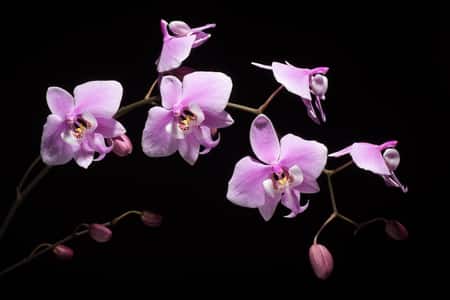
(1) Areanthes Ramosa Orchids: Not all Arenthes are low light, but these are extremely low;
(2) Bulbophyllum catenulatum Orchids: miniatures perfect for vivariums and terrariums;
(3) Bulbophyllum facetum Orchids: In fact, most all Bublophyllum prefer a low to medium light, but these are another speiceis within the genus that love the shade;
(4) Calanthe argenteo-striata Orchids: this Chinese low-light orchid is an evergreen terrestrial;
(5) Ceratostylis backeri (Java) Orchids: These low-light orchids absotulely love water and prefer to be watered everyday;
(6) Chrysoglossum (Pilophyllum) villosum Orchids: Found in Borneo, growing from 500 to 1500 fc
(7) Coelogyne prasina Orchids: This orchid will not tolerate even indirect sunlight if too close to the source, almost preferring a direct shade
(8) Dendrobium aberrans Orchids: Not all Dendrobiums are low light orchids. When searching for dendrobiums, make sure that you get a species that prefers low light, like the aberrans. Otherwise, you could come home with an extremely high light orchid.
(9) Dendrobium cuthbertsonii Orchids: The same advice applies from above. The cuthbertsonii is another species of Dendrobiums that do well in low light conditions. So always check the growing sheets and do your research on the correct species. Knowing just the genus name will not be enough to provide the correcting lighting. Other dendrobium species can include: heterocarpum, trichostomum, and stenophyllum.
(10) Dracula Orchids: These are not what you think, but the Dracula name came from the Dragon look. Usually used in vivariums and terrariums, these miniature orchids are perfect low-light orchids. Again, the different species inside the genus are quite numerous, so look for orchids that prefer under 1500fc, like:
Dracula benedictii var hubeinii, Dracula carderi (inaequalis), Dracula carlueri, Dracula christineana, Dracula decussata (I might add that these are especially cute.) , Dracula gaskelliana, Dracula gigas albescens, Dracula kareniae, Dracula marinii, Dracula navarroorum, Dracula ophioceps, Dracula orientalis…
The Dracula Orchid list of low lights can go on forever. Don’t just order a Dracula thinking it’s low light though. Most are, but always research.
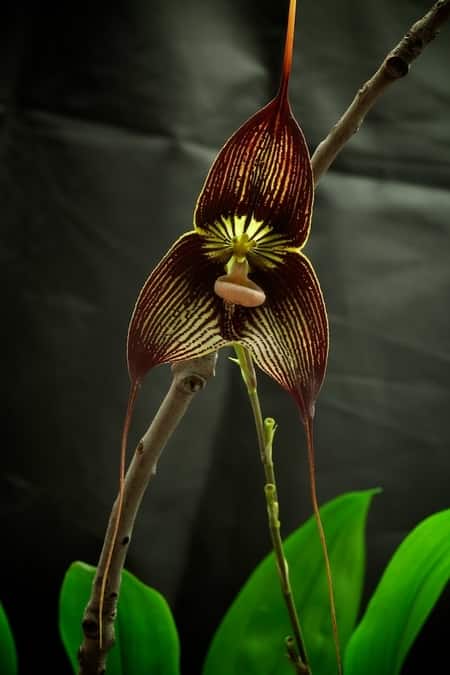
(11) Dryadella Orchids ( both species of albicans and elata): are excellent for low light conditions. These are also miniature orchids, and great for vivariums.
(12) Gastrochilus bellinus Orchids: beautiful, small waxy flowers grow on this one, almost like leopard spots with a fuzzy white lip… hard to explain, easy to become lost with amazement with it’s beauty. These are a tad bit fragrant, but nothing that will wipe you away with the intense smell. These low light orchids have a hint of sweet floral.
(13) Glossorhyncha Orchids: These orchids have small, light yellow flowers that blossom year round
(14) Haraella odorata Orchids: another mini orchid that has a maximum pattern and design to it.
(15) Lepanthes auriculate Orchids: If the mini orchids aren’t your thing, then try the Lepanthes auriculate. These low light orchids are still minis, but with bigger, larger leaves. Each leaf will normally have one blossom, that still is tiny, but the leaves make up for their size. Other Lepanthes orchids that love low light and almost pure shade are the Lepanthes gargoyle.
(16) Malaxis junghuhnii Orchids: These semi-decidious orchids are native to Indonesia, and prefer no natural sunlight. Bright shade is what makes them grow the best. Malaxis orchids are in the most part terrestrial, and have over 400 types of species, some of which, prefer high lights. So stay with the junhuhnii, or make sure that you do sufficient research before you purchase it. Good suggestions besides the jungugnii are the Malaxis polydon (orbicularis) and the Malaxis tenggerensis.
(17) Masdevallia bennettii Orchids: These orchids are amazing. The small, stunning flowers make the best of any terrarium—and yes—they are minis. Other Masdevallias that prefer low light conditions are: delhierroi, floribunda, hoeijeri, melanoxantha, pachyura, picturata, portillae, prodigiosa, rolfeana, laevilabris, and neophylla (attenuata).
(18) Maxiliaria Orchids: This is also a cute mini that makes is place in many terrariums and vivariums. Not all Maxillaries are low lights, so search for pseudo-reichenheimiana.
(19) Mediocalcar bifolium Orchids: These small red and white orchids look like glitter was poured over them. They also reign in the land on miniature orchids that love low light.
Mediocalcar versteegii are another species that you can try that will thrive in lower lighting.
(20) Paphinia rugosa Orchids: The four-inch blossoms on these orchids are fantastically beautiful. With the tiny red dots on a yellow background, these orchids fascinate with their intricate designs.

(21) Phaius pulchellus v. pulchellus Orchids: Phaius orchids are not that uncommon to find in larger nurseries, yet still I decided to include it in the uncommon list because not many people are aware of its existence. These larger orchids are grown in a more “soil-like” potting media, since they are terrestrial orchids.
(22) Phymatidium tillandsioides Orchids: A Brazilian native orchid, this puff ball of green leaves has small, delicate, white flowers dashed throughout. The foliage on this plants makes it worthwhile.
(23) Platystele umbellate Orchids: another miniature orchid that steals the spotlight. These low light orchids fan out to form an umbrella shaped circle, stealing the stage in your vivarium or terrarium.
(23) Platystele umbellate Orchids: another miniature orchid that steals the spotlight. These low light orchids fan out to form an umbrella shaped circle, stealing the stage in your vivarium or terrarium.
(24) Pleurothallis amphigya Orchids: With long slender leaf stalks, with the leaf at the very end, these orchids make stunning appearance. They are small, but the foliage makes them worth it. When they are in bloom, the fascinating red blossoms make it worth the wait. Other Pleurothallis to look into are the Pleurothallis chrysantha (circumplexa), fusca (hypnicola), immersa (black), mastodon, matudana, microphylla, nephroglossa, pachyglossa , racemiflora, ruscifolia, sanchoi, sandemanii, and the strumosa.
(25) Podochilus muricatus Orchids: Another orchid that is famous for it’s foliage, the podochilus muricatus has a cute tiny flower at the end of each leaf branch of leaves. These are perfect for beginner vivariums and terrariums, since the care is extremely basic.
(26) Porroglossum aureum Orchids: Not one of my favorites, but I had to include it in the list. These low light orchids look like little bug antennas, and once I associated them to that image, I’ve never given them a decent chance. Maybe you’ll be more just in your evaluation of them than I was. Another less bug-faced orchid species in the porroglossum are the Porroglossum hoeijeri, which also prefer not-so-bright shade. Of my favorite Porroglossums, the sergioi have a slight chance (also a low light orchid).
(27) Scaphosepalum anchoriferum (fortuna rojo) Orchids: Now these orchids are truely something unique to look at. The blood red color is striking, along with the prolonged shapes and structure of the lip. If you’re not too fond of the bright red color, try softer brownish-red antenniferum or a yellowish-black martineae. If patterns are more you’re thing, search for the swertifolium, which is dotted yellow and black.
(28) Trichosalpinx berlineri: Another low light orchid that hardly ever gets on a buyers list, but should be. The chamaelepanthes is another one, with its pendant cascading miniature flowers make perfect displays for the background of terrariums. The plant itself can grow quite large, but the flowers and leaves always remain small.
(29) Tristella hoeijeri Orchids: These star shaped flowers are delicate yet charming. The leaves form a ball of foliage, and slender flower spikes sprout from the middle. They can be confused for Masdevallias, since they almost look the same.
(30) Zootrophion (Cryptophoranthus) atropurpureus Orchids: I had to end the list with an orchid that started with the letter Z. 😊 These orchids don’t come in last place though. With their wonderfully vibrant red flowers, the zootrophion orchids close the curtains with style.
Don’t Stop Learning!
If you want to be included in more information and get a 14-page fertilization guide, please sign up for my newsletter. I don’t spam, but send emails out bi-monthly with some curious topics of interest. If you want more information, click here to go to a specific page on this website where I explain it more in detail.

Also, if you are looking for an orchid journal to keep your notes specifically about orchid care, check out my 2 solutions for that on this page. If note-keeping isn’t your thing, then there is a free excel spreadsheet that you can download. Click here for more information on how to do that.
If you subscribe to my newsletter, I will send you a 14-page guide on the main tips of orchid fertilizer. It is downloadable and you can print it out on your computer. I designed the guide to double up as a coloring book, just to make it fun.
I hope you’ve enjoyed these low light orchids, which can thrive in less than perfect conditions that other big box orchids would. Try them out in vivariums, terrariums, and mounting them on cork planks. The ways you can display low-light orchids are numerous; all you have to do is start.
Happy Cultivating!

Happy Cultivating!


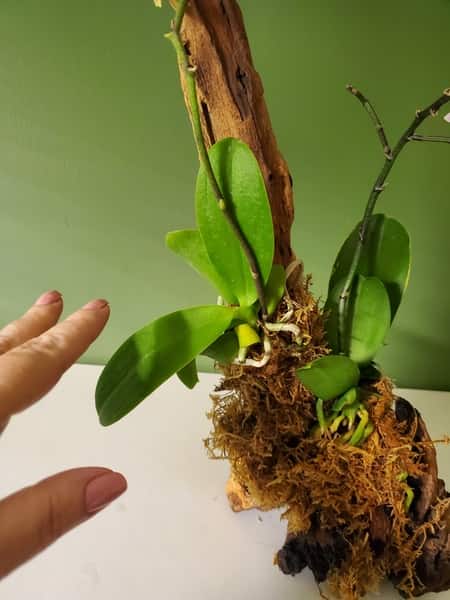
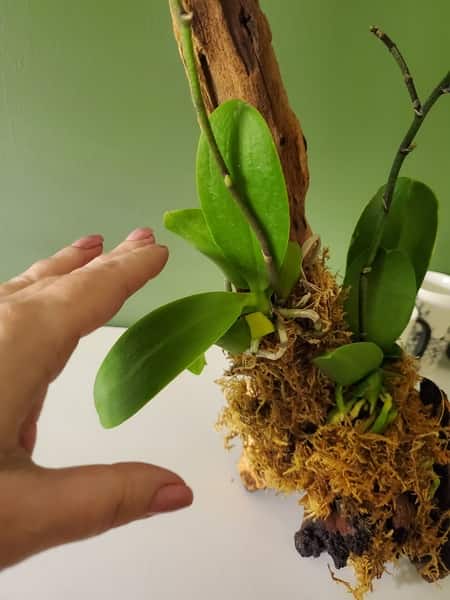
HI Willemma. I saw you posted my Pinterest Pin and the description I wrote for this post copied on your website. Please always add the link too, so people can find the real author of the post. The way you posted it looks a lot like plagiarism, since there is no reference to Orchideria or to me, the author. I’d appreciate it. 🙂 I saw that this post did it correctly, but another one on your site didn’t. Thanks!